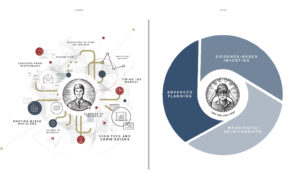Details Are Part of Our Difference
David Booth on How to Choose an Advisor
20 Years. 20 Lessons. Still Taking the Long View.
Making the Short List: Citywire Highlights Our Research-Driven Approach
The Tax Law Changed. Our Approach Hasn’t.
Keep It Simple

At conferences, I often hear experts advocate for private and alternative investments, claiming they’re essential for our largest and most sophisticated clients. They argue that these exclusive opportunities are what the wealthy truly want. These voices are growing louder, and the products they pitch are becoming more prevalent.
At Hill Investment Group, we take a different approach. We continue to value simplicity and transparency, regardless of how much money our clients have. We avoid complex, illiquid, and expensive options, even when others say they’re necessary. Our guiding question is this: once the marginal utility of wealth kicks in—when each additional dollar has less impact on your life—why take on added risks?
You can achieve extraordinary success by embracing what we call a “passive-aggressive” approach:
- Own global capitalism: Invest in broad market ETFs.
- Tilt toward premiums: Focus on factors identified by research to enhance returns.
- Rebalance regularly: Sell what’s done well, buy what’s lagged.
- Tax loss harvest: Capture losses to offset gains.
- Let it compound: Give your investments time to grow.
- Keep investing: Stay committed over the long term.
- Ignore the noise: Focus on your strategy, not the headlines.
By sticking to these principles, you can build and preserve wealth without getting caught up in the complexities that others might push.
Keep it simple!
August Newsletter Intro

At Hill Investment Group, we’ve always believed that financial success is more than just numbers on a spreadsheet—it’s about creating a life of order, focus, and peace of mind. Years ago, we commissioned a graphic that powerfully encapsulates this transformation. On the left, you see a person overwhelmed by chaotic systems, piles of disorganized papers, and a lack of clear direction—a visual metaphor for the financial stress that many people endure every day. On the right, that same person is calm, collected, and confident, having achieved clarity, order, and control over their financial life. Peace of mind. At last.
This transformation is at the heart of what we do every day for our clients. We help them move from financial chaos to financial freedom by focusing on what we call the 4 C’s, the cornerstones of our advice:
- Competence: Our expertise in evidence-based investing, financial planning, holistic asset allocation, investment selection and monitoring, and risk management ensures that every decision is informed and every strategy is sound.
- Coaching: We guide our clients to set realistic expectations, manage emotions and biases, and stick to their long-term goals, providing objective feedback and a trusted second opinion.
- Convenience: We save our clients time with personalized service, coordinated efforts with trusted professionals, and secure technology that integrates every aspect of their financial life.
- Continuity: Our approach is designed to support clients through life’s transitions, ensuring that their plans are adaptable and their legacy is preserved across generations.
At Hill Investment Group, we believe in helping you take the long view—transforming the complexities of your financial life into something simple, clear, and manageable. We strive to replace stress with confidence, uncertainty with clarity, and disorder with harmony.
This before-and-after image isn’t just a reflection of what we do—it’s a reminder of the peace of mind that comes with working with a firm that’s committed to your financial well-being, both now and in the future.
What We’re Reading
 Want to know what else we’re reading? Check out this piece on quiet compounding by Morgan Housel, which has a simple view on taking the long view and consider this thought-provoking take on retirement from The New York Times.
Want to know what else we’re reading? Check out this piece on quiet compounding by Morgan Housel, which has a simple view on taking the long view and consider this thought-provoking take on retirement from The New York Times.

